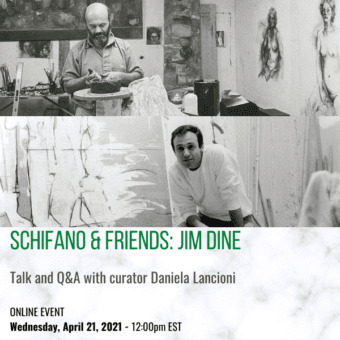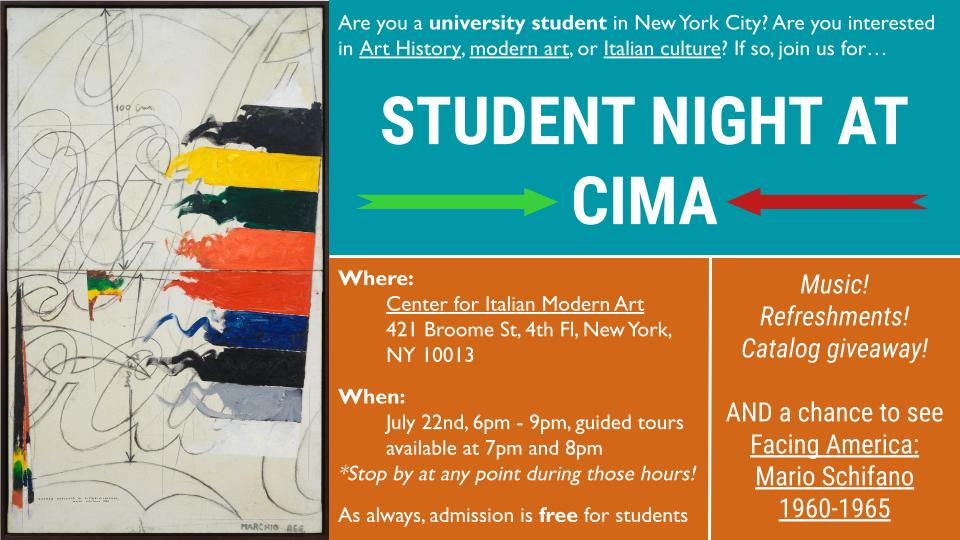Student Night at CIMA!
July 22, 2021
Join fellow students from Columbia, Cooper Union, CUNY, NYU, Pace, Parsons, SUNY, SVA and more for a night of Italian art, music, and refreshments! We celebrate the end of Summer Session courses with a special evening event open to all university students in the city. Come join us for one of the guided tours at 7PM or 8PM, and meet like-minded art lovers from different colleges and universities!
This is an in-person event. CIMA maintains extra cleaning practices in place as well as air sanitization. Mask wearing remains mandatory for non vaccinated individuals.
Limited capacity! RSVP here!
Schifano and Friends: Marina Sagona
July 02, 2021
This conversation and Q&A is part of a broader series titled Schifano and Friends, which explores the relationship and connections between Mario Schifano and the work of other American and Italian artists and intellectuals.
Marina Sagona is an Italian and American artist living in New York City. She works in a variety of visual media, often around the concepts of control, sometimes collaborating with other artists. Sagona was born in Rome and first started her artistic career as an illustrator working in the publishing world. In Rome she was assistant to artist Mario Schifano. In 1995, Sagona moved to the United States and began to contribute regularly to The New Yorker and The New York Times. From 2006 to 2008 she directed the contemporary department of Fiac Foundation for Italian Art and Culture. In 2014, she co-curated the show Dante Ferretti: Design and Construction for the Cinema at MoMA. Sagona is the recipient of the 2017 Strategic 50 Award, the 2019 Domus Artist Residency and the 2021 Chiquita Room Residency.
Free public access to this event is made possible thanks to funding from:
![]()
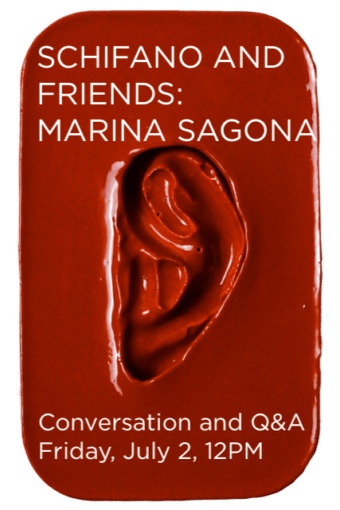
FRAMING WORDS & DRAWINGS
June 30, 2021
This virtual roundtable, conceived as a series of four talks, gathers scholars and poets around Words&Drawings, a suite of 17 works on paper completed in 1964 by American poet Frank O’Hara and Italian painter Mario Schifano. Our goal is to frame this project within the coeval collaborations between Frank O’Hara and artists such as Larry Rivers, Grace Hartigan, Jasper Johns, Joe Brainard, Norman Bluhm, and Alfred Leslie. In addition, we will contextualize this series in the broader field of poet-painter collaborations in the late Fifties and early Sixties.
Always held in private collection, the series Words&Drawings is visible in the US for the first time. It is currently on view at the Center for Italian Modern Art (CIMA) as part of the exhibition Facing America. Mario Schifano 1960-1965, curated by Dr. Francesco Guzzetti.
Click here to RSVP to the events. You will receive a confirmation email with the Zoom links to the four conversations and also a reminder before each event.
Program
June 17, 2021 – 12:00 pm (EST)
Collaborations Yesterday and Today. An Introduction to Words&Drawings.
Virginia Magnaghi, Scuola Normale Superiore, Pisa
Frank O’Hara’s European Collaborators.
Dr. Matthew Holman, UCL, London
“The poetic possibilities” of New Realism and Pop Art in the Transatlantic Circles of John Ashbery and Mario Schifano.
Professor Karin Roffman, Yale University, New Haven
June 24, 2021 – 12:00 pm (EST)
Why I am Not a Painter: Frank O’Hara and the Conundrum of Word and Image.
Professor Olivier Brossard, Université Gustave Eiffel, Champs-sur-Marne, and
Poet and Professor Ann Lauterbach, Bard College, Annandale-on-Hudson, NY
June 30, 2021 – 18:00 pm (EST)
Poets John Yau and Tony Towle in conversation
July 1, 2021 – 12:00 pm (EST)
Ron Padgett on Frank O’Hara, Joe Brainard and 1960s New York School Collaborations.
Professor Karin Roffman and Poet Ron Padgett in conversation
Invited speakers
Olivier Brossard is Associate Professor of American literature at Université Gustave Eiffel where he co-runs the Poets and Critics program: www.poetscritics.org. He co-founded the Double Change collective, an online magazine and reading series in Paris www.doublechange.org. Olivier Brossard is joca seria éditions American poetry series editor: his most recent translation is John Ashbery’s Self Portrait in a Convex Mirror, in collaboration with Pierre Alferi and Marc Chénetier (joca seria, 2020).
Matthew James Holman is a writer and critic who received his PhD in 2020 from University College London, where he also teaches. Matthew’s research focuses on the poet Frank O’Hara’s curatorial career, as well as the cultural Cold War and the relationship between language and art. He has received research fellowships at Yale University, the Smithsonian American Art Museum, the Terra Foundation for American Art in Giverny, and the John F. Kennedy Institute for North American Studies in Berlin, where he was supported by a Leverhulme Trust Study Abroad Studentship. His art writing, often on the New York School, has appeared in Frieze, Burlington Contemporary, The Art Newspaper, The White Review, and Apollo. Matthew is currently a Teaching Fellow at Queen Mary University of London and The Slade School of Fine Art.
Ann Lauterbach is a poet and essayist born and grew up in New York City. She spent seven years in London, working as an editor at Thames and Hudson publishers, curator of readings at The Institute for Contemporary Arts, for Fabbri and Partners (Milan and London) and as Production Manager at the art publishers Petersburg Press. Returning to New York, she worked in various art galleries before becoming a full-time teacher. She is the recipient of Guggenheim and MacArthur Fellowships. The author of ten books of poetry, several collaborations with visual artists, and three books of essays, she is Schwab Professor of Languages and Literature at Bard College, Annandale-on-Hudson, New York.
Virginia Magnaghi is a PhD candidate in Art History at the Scuola Normale Superiore in Pisa, Italy, and a current Research Fellow at the Center for Italian Modern Art in New York. Her research at CIMA deals with the early figurative works of Mario Schifano, and with his connections to the New York scene of artists and poets during his stays in the US during the Sixties. For her PhD, she is studying the pictorial and literary representations of natural landscape during Fascism.
Ron Padgett is an American poet. Born in Tulsa, Oklahoma, in 1942, he has lived mostly in New York City since 1960. Among his many honors are a Guggenheim Fellowship, a Civitella Ranieri Fellowship, the American Academy of Arts and Letters poetry award, the Shelley Memorial Award, the Robert Creeley Award, the Poetry Society of America’s Frost Award, and grants from the National Endowment for the Arts. The French government made him an Officer in the Order of Arts and Letters. Padgett’s How Long was Pulitzer Prize finalist in poetry and his Collected Poems won the Los Angeles Times Prize for the best poetry book of 2014 and the William Carlos Williams Award from the Poetry Society of America. For many years he taught poetry writing to children and edited books on that subject. He is also a translator of twentieth-century French poets Guillaume Apollinaire, Pierre Reverdy, Valery Larbaud, and Blaise Cendrars, and a co-translator of Chinese poet Yu Jian. Padgett’s own work has been translated into eighteen languages, with recent books in Portuguese, Spanish, French, Greek, Polish, and Italian (Non praticare il cannibalismo). In addition to his poetry, he is the author of biographies and memoirs of Joe Brainard, Ted Berrigan, and his father, as well as Motor Maids across the Continent, a novella. He has collaborated with artists such as Jim Dine, George Schneeman, Joe Brainard, Bertrand Dorny, Rory McEwen, and Alex Katz. Padgett’s most recent poetry collection is Big Cabin. Forthcoming in 2022 is one entitled Dot. He is currently writing a memoir of his life-long friend Dick Gallup, the poet. Seven of Padgett’s poems were used in Jim Jarmusch’s film, Paterson. For more information, go to www.ronpadgett.com.
Karin Roffman is Associate Director of Public Humanities and a Senior Lecturer in Humanities at Yale University. She is the author of two books, most recently The Songs We Know Best: John Ashbery’s Early Life (FSG, 2017), which was named one of the 100 notable books for 2017 by the New York Times. She has published essays on poetry, music and art in Raritan, Evergreen, Artforum, Rain Taxi, Yale Review and others, and she was the PI for “John Ashbery’s Nest“ (2019) a digital humanities project on (http://vr.ashberyhouse.yale.edu/) at the Yale DHLab.
Tony Towle has been associated with the New York School of poetry since 1963, when he took workshops with Frank O’Hara and Kenneth Koch at the New School. Since then he has published thirteen books of poetry, most recently Noir, from Hanging Loose Press in 2017. He has also written Memoir 1960-63 (Faux Press, 2001), about his early years of becoming a poet in New York. From 1964 to 1982, he was secretary and adminstrative assistant at Tatyana Grosman’s Universal Limited Art Editions (ULAE), publisher of original prints by Jasper Johns, Barnett Newman, Helen Frankenthaler, Robert Rauscenberg, Larry Rivers, Robert Motherwell, Lee Bontecou, James Rosenquist, and other notable artists. This past year, Vehicle Editions brought out My First Three Books, a combination of an interview with Towle about how his early books came into existence; poems from that period, with a CD of the poet reading them; and contemporaneous photographs, many from ULAE. Towle’s latest award was from the Foundation for Contemporary Art in 2015.
John Yau has published books of poetry, fiction, and criticism. His latest poetry publications include a book of poems, Further Adventures in Monochrome (Copper Canyon Press, 2012), and the chapbook, Egyptian Sonnets (Rain Taxi, 2012). His most recent monographs are Catherine Murphy (Rizzoli, 2016), the first book on the artist, and Richard Artschwager: Into the Desert (Black Dog Publishing, 2015). He has also written monographs on A. R. Penck, Jasper Johns, and Andy Warhol. In 1999, he started Black Square Editions, a small press devoted to poetry, fiction, translation, and criticism. He was the Arts Editor for the Brooklyn Rail(2007–2011) before he began writing regularly for Hyperallergic Weekend. He is a Professor of Critical Studies at Mason Gross School of the Arts (Rutgers University).
This series of events is conceived and organized by CIMA fellow Virginia Magnaghi, and is made possible thanks to generous funding from Christie’s Inc.
![]()
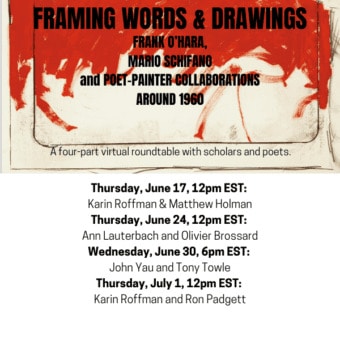
Schifano & Friends: Gerard Malanga
June 23, 2021
This in-person event, in partnership with Elizabeth Street Garden, is dedicated to the poetry and underground cinema of Gerard Malanga.
This event will begin at CIMA at 6:00, featuring an interview with poet, photographer and filmmaker Gerard Malanga, as well as a reading from his latest book of poems, The New Mélancholia (Bottle of Smoke Press, 2021). A book signing with the author will follow. The evening will also feature a screening of In Search of the Miraculous, a 1967 movie which includes contributions by Mario Schifano, among other artists and filmmakers of the time.
An emblematic protagonist of the underground New York scene ’60s-‘70s, Gerard Malanga is a multifaceted and prolific creator whose work intersects multiple genres and intellectual milieus. A poet, a photographer, a director and actor, he was one of “Andy Warhol’s superstars.” As chief assistant for Warhol’s Factory in the mid-Sixites, he gave an important contribution to the making of Warhol’s famous silkscreens and films. He has published numerous collections of poems, including Chic Death (1971), Mythologies of the Heart (1996), No Respect (2001), and Cool & Other Poems (2019). His work has appeared in Poetry, Raritan, Yale Review, Harvard Review, The Paris Review, Partisan Review, The New Yorker, Poetry Foundation, and the Italian literary journal Nuovi Argomenti, among others. His iconic photographs of figures such as Mick Jagger, Keith Richards, Iggy Pop, Patti Smith, John Recy, Allen Ginsberg and the Beats, have been coveted by publishers and connoisseurs worldwide and can be found in monographs such as Screen Tests: A Diary (in collaboration with Warhol, 1967), Resistance to Memory (1998), Screen Tests Portraits Nudes 1964-1996 (2000), Someone’s Life (2008). Having been introduced to underground cinema by Willard Maas e and Marie Menken, Malanga went on to produce short movies throughout the 60s that were screened in American and international film festivals. One of these, In Search of the Miraculous, was created during his 1967 trip to Italy, where he took part in the happenings orchestrated by Mario Schifano at the renowned Piper Club. In Rome, he met and befriended artists, writers and intellectuals like Franco Angeli, Tano Festa, Elsa Morante, Fernanda Pivano, Peter Hartman, Giangiacomo Feltrinelli, and Flavio Lucchini. After the presentation of In Search of the Miraculous at the 1967 edition of the Bergamo Film Festival, writer Alberto Moravia described the movie as “a series of images strangely beautiful and revealing.”
CIMA
6:00-7:30 pm
The New Mélancholia (2021): Book presentation, poetry reading, and book signing
COVID-19 policy: this is an in-person event at CIMA. Social distancing and mask wearing are required.
Elizabeth Street Garden
8:00 pm
In Search of the Miraculous (1967): Film screening
In partnership with Elizabeth Street Garden.
For information about how you can help save Elizabeth Street Garden, visit www.elizabethstreetgarden.com.
Free public access to this event is made possible thanks to funding from:
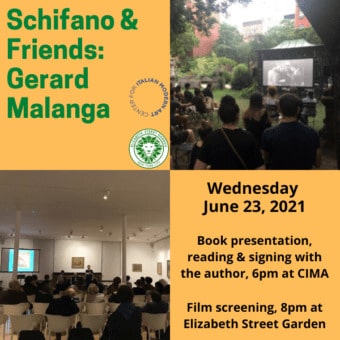
Schifano and Friends: Larry Rivers
June 10, 2021
This talk and Q&A is part of a broader series titled Schifano and Friends, which explores the relationship and connections between Mario Schifano and the work of other American and Italian artists and intellectuals.
David Joel, Executive Director of the Larry Rivers Foundation, will focus his talk on the life and art of Larry Rivers, while looking at connections to Mario Schifano’s art.
Free public access to this event is made possible thanks to funding from:
![]()
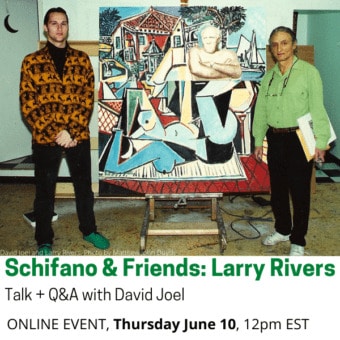
Schifano and Friends: Frank O’Hara
May 20, 2021
This talk, part of a broader series titled Schifano and Friends covers the Italian artist’s friendship with poet Frank O’Hara, as well as the reciprocal influence each had on the other.
This series of talks and conversations with art historians, writers, artists, and curators, will highlight thematic and aesthetic intersections between the work of Schifano and that of American artists from the 1950s and 1960s.
Raphael Rubinstein is a New York-based poet and art critic whose numerous books include Polychrome Profusion: Selected Art Criticism 1990-2002, The Afterglow of Minor Pop Masterpieces and The Miraculous. He edited the anthology Critical Mess: Art Critics on the State of their Practice and is widely known for his articles on “provisional painting.” His poetry has appeared in, among other places, Grand Street, Fence and Harper’s Magazine and in Best American Poetry 2015. From 1997 to 2007 he was a senior editor at Art in America, where he continues to be a contributing editor. He is currently professor of critical studies at the University of Houston. In 2002, the French government presented him with the award of Chevalier in the Order of Arts and Letters. In 2010, his blog The Silo won a Creative Capital/Warhol Foundation Arts Writers Grant. In 2014 The Silo was given a Best Blog Award of Excellence by the International Association of Art Critics. In April 2017, The Miraculous: Houston, a public-art installation by artist and wife Heather Bause Rubinstein, based on his book The Miraculous, debuted as part of the CounterCurrent Festival.
This program is made free to the public thanks to support from:
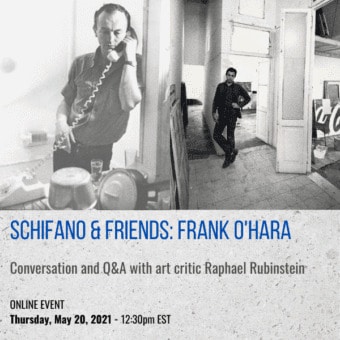
Something Else: Schifano and Music – Luciano Chessa
May 13, 2021
This mini-series of conversations highlights the intersections between the work of Mario Schifano, the world of Jazz music, and Schifano’s own involvement in the underground music scene of the 1960s.
Luciano Chessa is a composer, conductor, performance artist, pianist, and music historian specializing in 20th-century Italian and 21st-century American repertoire. His compositions include the experimental opera Cena oltranzista nel castelletto al lago—a work of over 55 hours of fasting that was entirely livestreamed—and A Heavenly Act, an opera commissioned by the San Francisco Museum of Modern Art, with original video by Kalup Linzy. In New York alone, Chessa has been commissioned multiple times by the Performa Biennial, and in 2014 he presented three concerts at the Solomon R. Guggenheim Museum as part of the exhibition Italian Futurism, 1909-1944: Reconstructing the Universe. Chessa is the author of Luigi Russolo Futurist. Noise, Visual Arts, and the Occult (2012), the first monograph dedicated to Russolo and his “Art of Noise.” In 2009, his Orchestra of Futurist Noise Intoners (OFNI) was hailed by the New York Times as one of the best events in the arts; it continues to tour internationally.
He will discuss Mario Schifano’s foray in music production with the underground rock band Le stelle di Mario Schifano. With CIMA Fellows Marica Antonucci and Carlotta Vacchelli.
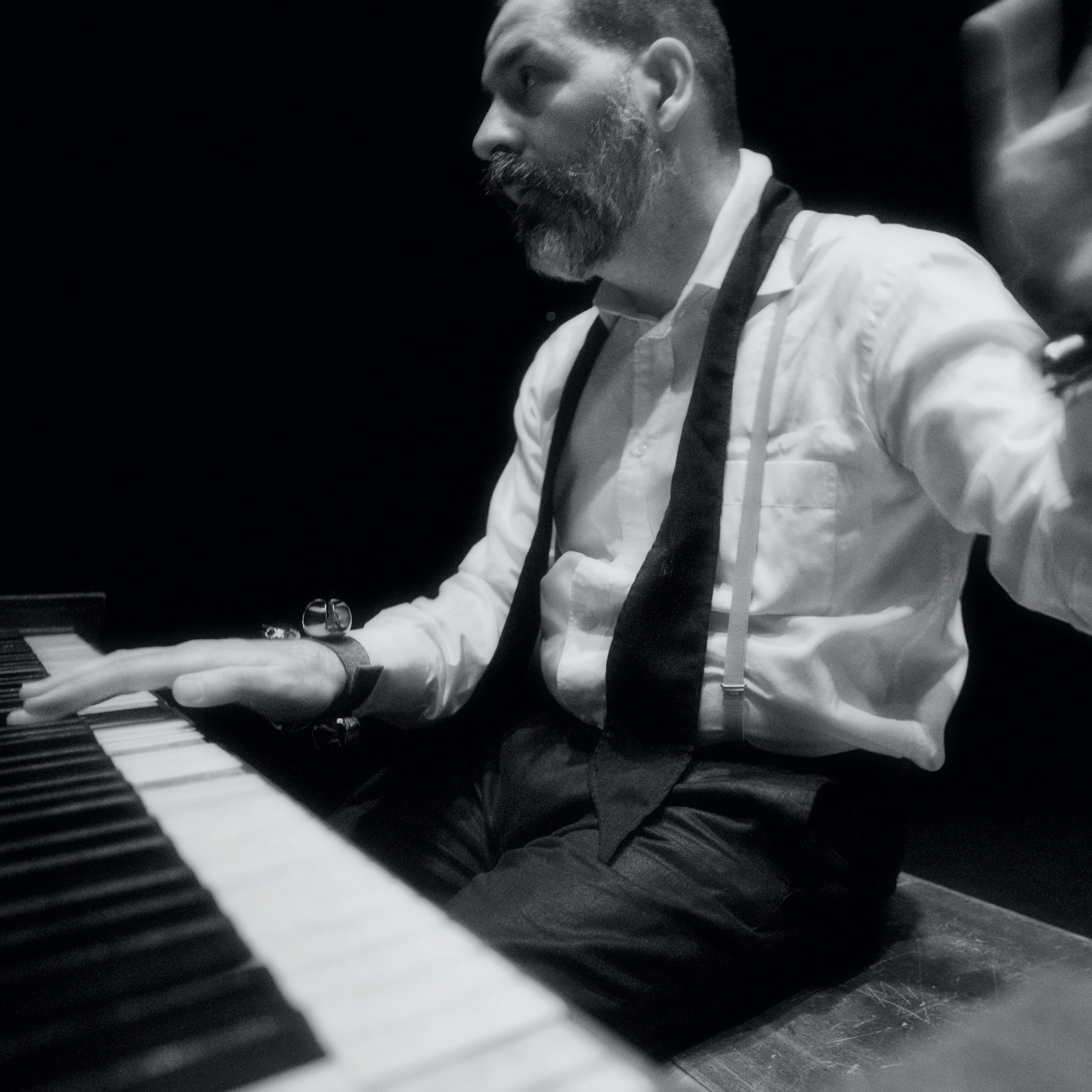
This program is made free to the public thanks to support from:
![]()
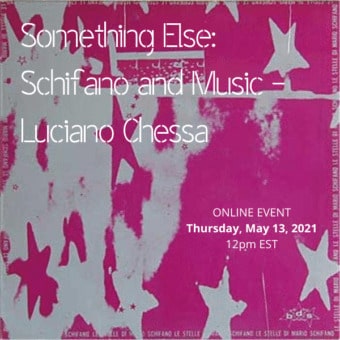
SCHIFANO & FRIENDS: FRIGIDAIRE
May 12, 2021
This conversation with Vincenzo Sparagna and Filippo Scòzzari explores the collaboration between Mario Schifano and the Italian counterculture magazine Frigidaire through the 1980s and 1990s. Among the themes addressed, the interview discusses the involvement of Schifano in the foundation of the magazine, the representation of his figure and his art through comics and fiction, as well as his friendship with the group of artists that animated the magazine.
Vincenzo Sparagna is one of the most active figures in the history of Italian counterculture. Publisher, journalist, essayist, writer, and illustrator, Sparagna collaborated with the weekly magazine “Il Male”, a hotbed of the satire and caricature of Italian politics and society between the end of the 1970s and 1980s. In 1980 Sparagna founded the revolutionary magazine of cultural dissemination and information “Frigidaire”, bringing about a decisive change in the history of Italian comics and graphic narrative. The original nucleus of “Frigidaire” is composed by the authors Filippo Scòzzari, Stefano Tamburini, Andrea Pazienza, Massimo Mattioli, and Tanino Liberatore, who had previously founded the legendary magazine of underground comics, “Cannibale”. Sparagna has since been at the center of a network of artists, and intellectuals, variously active in the field of visual and graphic arts: painting, photography, comics, and illustration. Among the multiple magazines that he started and edited, there are “Lunedì della Repubblica”, “La piccola Unità”, “Il nuovo Male”. In 2005, Sparagna founded “La Repubblica di Frigolandia”, which he currently directs, together with illustrator and graphic designer Maila Navarra. An artistic and creative crossroads, “Frigolandia” is the center, the archive, and the current publishing place of “Frigidaire”.
A key figure in the underground milieu of Bologna and Rome in the 1970s and 1980s, Filippo Scòzzari is one of the most influent master of Italian comics. A painter, a writer, a graphic artist, and an illustrator, Scòzzari participated to the fundamental experiences of Italian alternative culture, active between magazines, radio stations, and artistic centers. Among them, “Re nudo”, “Il Male”, “Radio Alice”, “Cannibale”, “Traumfabrik”, “Alter Alter”, and “Frigidaire”. With the group “Cannibale” and “Frigidaire”, Scòzzari operated critically in the Italian comics culture, exploring possibilities that had never been investigated before, and expanding the use of comics in an artistic direction, and as a tool for socio-political investigation. He contributed to disseminate a new aesthetic awareness around the medium of comics. His distinctive comics technique involves a constant clash between the fineness of the drawing and the color, and the contents, intentionally caricatural, grotesque, and anti-idealistic, provoking an effect of unveiling of the mechanisms behind this medium, and an irreverent anti-bourgeois polemic. Examples of this tendency are “Suor Dentona”, “Dottor Jack”, “Primo Carnera”, as well as the comics adaptations of Tommaso Landolfi’s “Mar delle Blatte”, and “The Blue Dahlia” by Raymond Chandler. Among his writings, his autobiographical memorial “Prima pagare poi ricordare”, and the play “Cuore di Edmondo”, inspired by Edmondo de Amicis’ novel “Cuore”. His science fiction comics have been recently collected in “Lassù no” by Coconino press (2019), which published in 2020 the graphic novel edition of “Il mar delle blatte”.
Carlotta Vacchelli is a Research Fellow at CIMA, with a project on the artistic relationship between Mario Schifano and the countercultural magazine Frigidaire; she also works on the vistual and literary portraits and representations of his Schifano and his art. She earned an M.A. (2017) and a Ph.D. in Italian Studies (2020) at Indiana University – Bloomington, as well as an M.A. in Italian Philology at the University of Pavia (2015), with a thesis on Dino Buzzati’s comics and pictorial production. Her Ph.D. dissertation focuses on the influence of artist Andrea Pazienza on contemporary Italian comics and graphic novels, literature, cinema, and pop music. She has curated the exhibition La funzione-Pazienza at the Centro Fumetto Andrea Pazienza (2020, Cremona), and the namesake catalogue. She is Associate Editor for the online peer-reviewed journal Simultanea. A Journal of Italian Media and Pop Culture. She has published about Italian literature, art, comics, and cinema for Italian and international scholarly journals (Studi Italiani, Italica, Italian Quarterly, Studi buzzatiani, International Journal of Comic Art, Cultura & Comunicazione).
Something Else: Schifano and Music – James Demby
May 06, 2021
This mini-series of conversations highlights the intersections between the work of Mario Schifano, the world of Jazz music, and Schifano’s own involvement in the underground music scene of the 1960s.
This conversation and Q&A with James Demby, musician, composer and professor at the Conservatorio Luigi Cherubini in Florence, will explore Schifano’s passion for the New York Jazz scene and its echoes in the Rome of those years.
James Demby is a musician, composer, and professor of Teoria ritmica e percezione musicale at the Conservatorio Luigi Cherubini in Florence, Italy, where he also directs the course of Ewe drums. The son of actress and screenplay writer Lucia Drudi and African-American poet and novelist William Demby, James personally knew Schifano since the 1960s thanks to his family’s connections to the Italian art world of the era. His family collection included works by major Italian artists, such as Fabio Mauri, Mario Schifano, and Toti Scialoja.
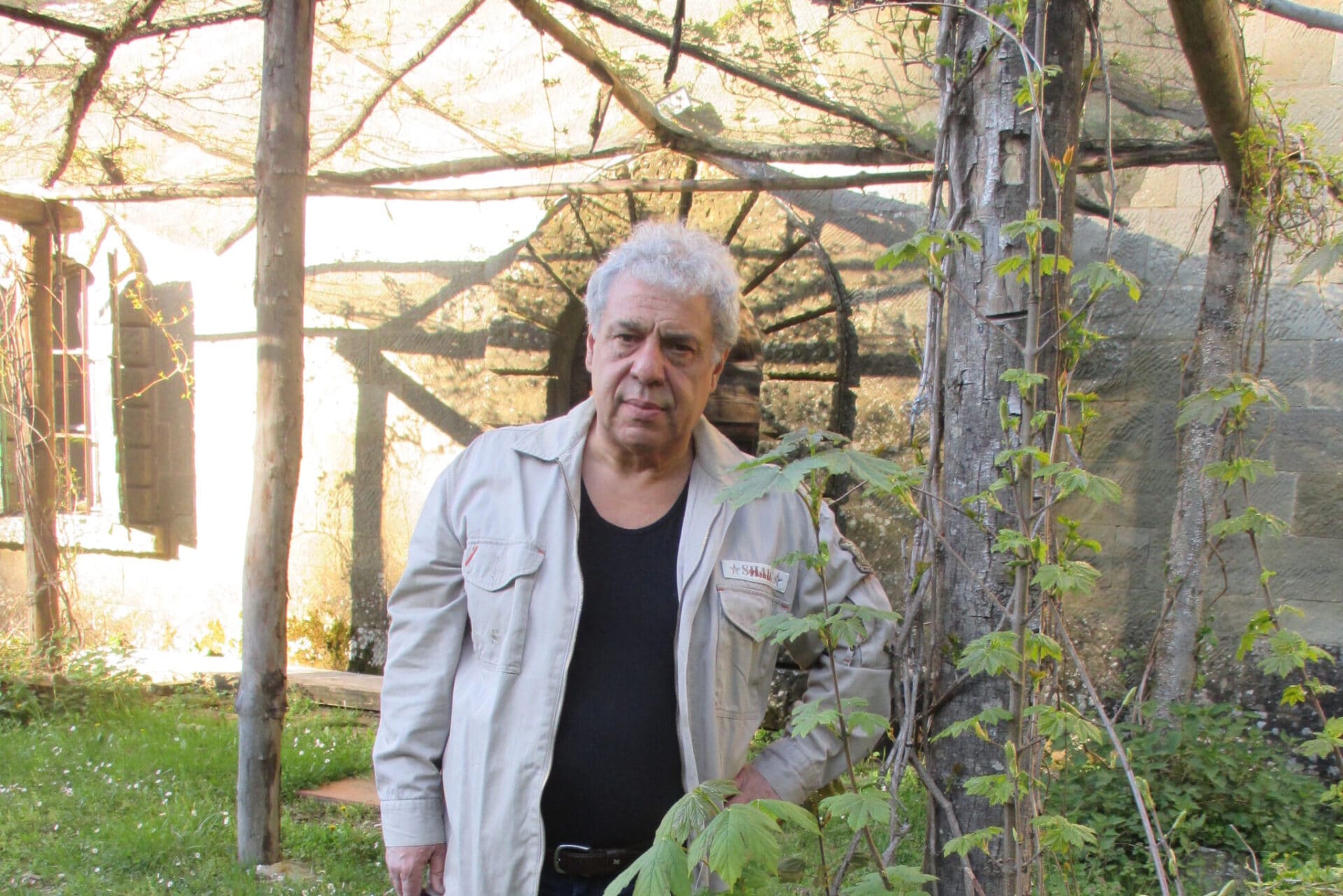
This program is made free to the public thanks to support from:
![]()
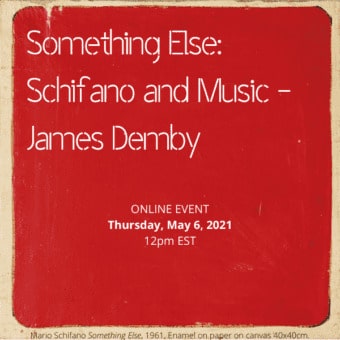
Schifano and friends: Jim Dine
April 21, 2021
The series of talks and conversations with art historians, writers, curators, and artists, highlights thematic and aesthetic intersections between the work of Mario Schifano and his American peers.
This talk and Q&A by Daniela Lancioni, Senior Curator, Palazzo Delle Esposizioni, Rome, will introduce the figure of Jim Dine and hint at possible relationships between Schifano’s and Dine’s work.
Daniela Lancioni was born in 1959 in Rome where she currently lives. She is senior curator at the Palazzo delle Esposizioni in Rome. Between 2009 and 2002 she founded and directed the Spazio per l’arte contemporanea Tor Bella Monaca. Among the exhibitions she has curated at the Palazzo delle Esposizioni: Jim Dine, 2020; Mostre in mostra, 2019; Cesare Tacchi. Una retrospettiva, 2018; Anni 70. Arte a Roma, 2013-2014; Carlos Amorales, 2011; Giulio Paolini. Gli uni e gli altri (L’enigma dell’ora), 2010. Among the exhibitions she curated at the Spazio per l‘arte contemporanea: 20 mostre a La Salita tra il 1960 e il 1978, 1998-1999; Giacinto Cerone, 1999-2000; David Tremlett, 2000; Giuseppe Penone. Spoglia d’oro su spine d’acacia, 2002. She has curated additionally, Italia contemporanea. Officina San Lorenzo, MART, Rovereto 2009; Tano Festa. Da Mondrian a Michelangelo. Opere dal 1963 al 1978, Cinecittàdue arte contemporanea, Rome 2005. Among her publications: Roma in mostra 1970-1979. Materiali per la documentazione di mostre azioni performance dibattiti, Rome 1995; Giulio Paolini. Quadrante, Rome 2002, curated catalogues include: Incontri…Dalla collezione di Graziella Lonardi Buontempo, Rome 2003; Giuseppe Penone, Rome 2008; she has collaborated also on the monographs Spalletti, Naples 1999; Giuseppe Penone The Inner Life of Forms, New York 2018.
Our digital programming is made free thanks to sponsorship from:
![]()
